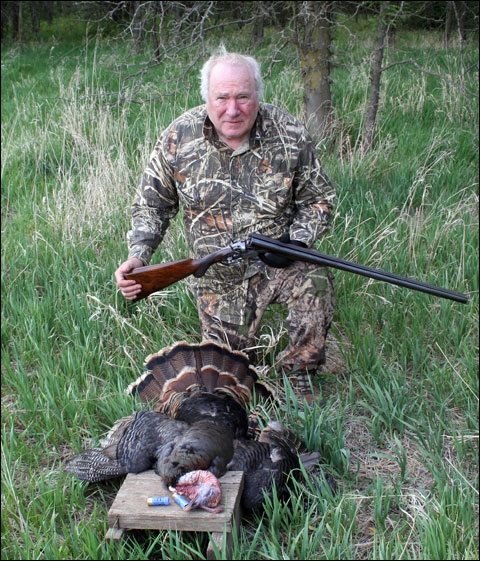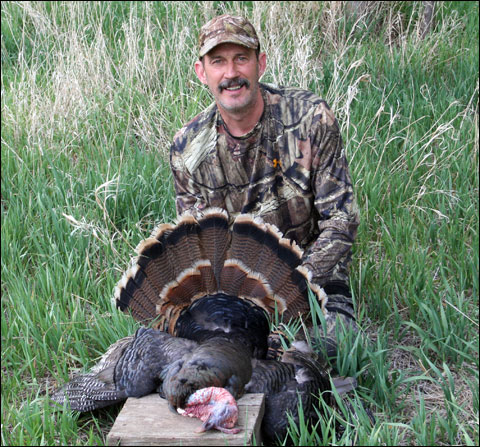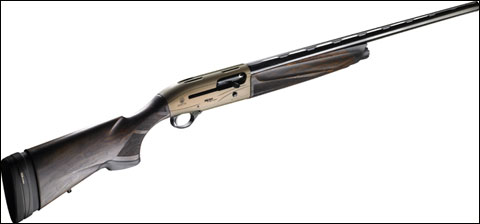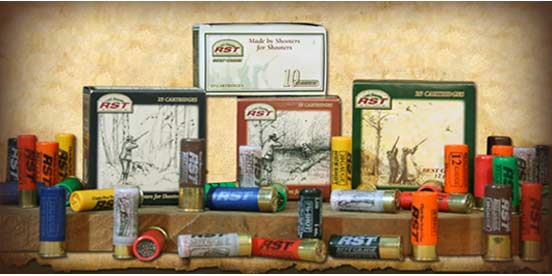One Shot, One Memorable Experience in Kansas Turkey Hunting with a Vintage Shotgun

The drive from Denver had been uneventful, which was good. I listened to a stack of CDs hoping to learn how to say ‘good morning’ in Italian and trying not to spill Diet Pepsi all over the box, while anguishing as the gas gauge plummeted down like weights at the gym. On the rural roads the weathered buildings and farm houses with sharp angled roofs reminded me of my family car trips from Long Island to Miami Beach when my age was written in single digits.
When I exit a means of transportation—automobile, jet airliner—after eight or nine hours of sitting or driving, I’m inclined to want to experience a change in scenery dramatically different from the one I left. Maybe hear Italian spoken or see a bunch of shops featuring exotic wines, cheeses, pastries and maybe I could nosh on some thin crust pizza with smoked salmon and capers. This was not to be after my long drive when I arrived at Dr. Mark Steffen’s home in central Kansas just before midnight on a Friday night this past May.
The night’s crisp, still air boasted a delicious floral scent and there was enough light to show dark thunderheads ominously gathering in the eastern sky. But contrary to Toto’s admonition to Dorothy, well, I was in Kansas rather than, for example, Val Trompia or Cordoba.

Mark Steffen with the turkey of the day.
Mark Steffen is a Boone and Crockett Club (B&CC) Regular Member, editor of its Fair Chase Magazine and past second vice-president of Pope and Young. I came to be at the good doctor’s home as a consequence of several events, the little rivulets in one’s life that, upon, reflection causes one to think, ‘What are the odds of that happening?’ and each event, improbable in its own right, surprisingly leads to the next one.
I met Mark after reading about B&CC’s inaugural Hunt Fair Chase Award that was presented in 2013 to Matt Rippentrop by iconic hunter and writer Craig Boddington at the 28th Big Game Awards in Reno, Nevada. I reached out to Mark by telephone and learned we had common experiences, goals and philosophies. Mark invited me to speak at the annual B&C conference which was held this past December at the Brown Palace Hotel in Denver. One thing led to another and a friendship developed. He invited me to hunt turkeys on his properties in Hutchinson, Kansas.
After a leisurely mid-morning breakfast, our first afternoon began with a delicious lunch at Roy’s BBQ. “Why would anyone fly to Paris when they can eat right here?” I quipped to Anne, the husky-voiced manager /cashier as she yelled out orders, “Number 4, brisket and chicken are ready!” Her laugh shook the restaurant’s foundation.
My Armory
I brought two shotguns and two ammunition loads, each different in application and theory. Beretta had loaned me its A400 XPlor Unico 12 gauge semi-auto. Its Kick-Off system dramatically reduces recoil. I share the shotgun with wounded warriors and paralyzed veterans when I participate in their fundraising shooting events. They love the gun! With its 3 ½-inch chamber, 30-inch barrel and scratch, rust and stain resistant green alloy receiver, this hunting shotgun is about as good as it gets in the semi-auto configuration.

Beretta’s A400 XPlor Unico.
After a discussion with Jackie Stenton at Fiocchi USA, I paired the Unico with a Golden Pheasant load from the Extrema series. The cartridge we selected pushed 1⅜-ounce of nickel plated #5’s at 1250 fps. I had used that Golden Pheasant load on pheasant and, when I did my job, the birds dropped like anchors. I could have chosen a faster load but any benefit from the added velocity didn’t justify, in my opinion, the additional recoil, particularly since I’d likely not take a shot past thirty yards.
My other shotgun is one of my most precious: a side-lever external hammer steel-barrel pigeon gun built in the late 1880’s during the brief partnership of Watson & Hancock. Their shop was located at 308 High Holborn in London and existed, as best as I could ascertain, from 1886 through 1890. The fitting of the doll’s head is so perfect as to approach the erotic. No lasers, no CNC machinery were used in its construction; just men and their muscles and their pride produced this magnificent firearm.
The Golden Pheasant loads were incompatible with this aged shotgun. Over the past decade, I used only re-loaded ammunition with Hodgdon 7625 powder for my vintage shotguns. According to Chris Hodgdon, I note tearfully, the powder is no longer in production. I had no reloads with hunting-size shot. Several of my Vintager pals have been pleased using low-pressure RST ammunition in their vintage shotguns. I called up RST and asked if some appropriate cartridges might be supplied for this story. I was delighted to receive a selection of 3 inch and 2 ½ cartridges.

An assortment of RST shotshells.
We began that afternoon’s hunt at Mark’s ranch in Kingman County. Getting to the initial location required us to cross a small meandering stream. It wasn’t quite crossing the Delaware but the shallow water was cold as ice and I was nervous carrying the Unico. We walked a mile or so to a pastoral area with intermittent sections of open ground nestled among thick stands of trees. We heard several blasts of gobbling but they seemed as far away as Idaho.
Mark gave me a tutorial on turkey hunting. First there is the ethical component. You have to know your target and you have to know the law. You have to know what you can shoot and what you cannot shoot. I had purchased my license on-line and, thus, was in legal compliance in that regard.
We looked for places to sit down in a wooded thicket about twenty yards from a corn field. Mark pointed out growths of poison ivy. He quipped, “If I can’t be miserable, I can’t be happy.” Whatever!
Mark made a few strokes on a curious device, rubbing one piece of wood against another, producing a high-pitched ‘cawing’ sound that seemed to penetrate the air like a knife. How this scratching noise would appeal to a turkey, I don’t know, but Mark is the expert, so I just kept quiet. A female appeared shortly thereafter in the cornfield, pecking about as if she had all the time in the world, which perhaps she had.
Turkey hunting is about patience and about sensations. Motionless within or near sections of the iconic waves of grain, wheat, canola, soybeans, there is a sense of infinity, but more impacting, a sense of solitude. Mark was a few yards away in awkward repose, sitting quite still among flies and mosquitoes, either thinking deeply or dozing off.
A hunt can teach the virtues of clarity and restraint, which is a positive experience. Some hunters speak of the waiting, the stillness, as a Zen-like experience; a time of contemplation, where one’s thoughts turn inward and get kneaded like a lump of brioche dough. They hear a song in each gentle gust of wind; find solace in studying the movement of ants and hope to discern a genetic grand plan in those bugs. Some hunters have an epiphany-like experience.
I am not one of those hunters.
I was bored, fidgeting, trying to get comfortable, my mind, such as it is, turbulent like greyhounds at the starting gates, if you know what I mean. I lamented not bringing a book, or half a dozen books. Yet, if I had, I’d fear that every movement, every turn of a page, no matter how controlled, would be observed by these birds with their alleged preternatural eyesight from as far away as the Long Island Expressway, causing them to scoot off with a chuckle infused in their gobbling.
We walked to another area and sat again, repeating the process. Success eluded us. We saw no toms. We left at sun-down, being the beneficiaries of a magnificent sunset. We again cautiously crossed the stream and walked the half mile or so to Mark’s truck.
My One Shot
We returned to the Kingman section the next morning, my second and last day. We walked to another section; heard a tom or two. We sat, waited, tried to be still for hours. Not responding to Mark’s virtuoso-like manipulation of the turkey call, no turkey trotted into view.
Late that afternoon Mark took me to another section he called “The “Huntin’ Quarter” in Rice County. “We usually have luck there,” he told me. I shrugged. By then my mind had tip-toed into thoughts of thin-crust pizza and the Italian red wine from Montalcino I brought. From a two-way county road we drove about a mile on a dirt road bounded on the left by a lush canola field, dense and green and representing that image of what successful farming is supposed to yield. Mark had told me that we would shoot out of a blind and would not walk through woods and thickets or cross rivers to get to it. I decided to bring the Watson & Hancock, since the chance of scratching it appeared about zero.

The author with his Watson & Hancock and the tom taken with it.
We trundled across the canola field about a quarter mile and settled into the blind. It was a skeletal wood structure, not where I’d want to camp but good enough. Mosquito spray was judiciously applied. I then placed the camouflage netting over my head and sat. And sat. I feared moving. The heat of my breath bounced back from the netting. Perspiration cascaded down my face. I hesitated to wipe it away. I thought of Ahab seeking the White Whale and wondered if his quest was easier. I loaded an RST shell into each chamber. I selected a 2 ½ inch cartridge with a one-ounce load of #5’s pushed at 1175 fps. I did not cock the hammers. We waited.
Three large hens strutted into the open area, seemingly fully cognizant that the law was on their side and that the big gun would not to be used against them. Mark wagged a finger at me and mouthed, “Don’t shoot.”
We heard a gobble. The source seemed close. Three majestic young whitetail bucks, their antlers draped in velvet; ambled into the area thirty yards away. That view, in and of itself, was worth the trip. Nonchalantly they ate leaves and then walked off, disappearing into the forest like smoke at a campfire. Mark made a few more shrill scratching sounds with his turkey call and he emitted such a convincing turkey yelp I regretted not bringing along my traditional Thanksgiving mushroom and Sherry gravy.
We heard another gobble, longer in duration and closer. The mosquitoes were beyond annoying and the setting sun was directly above a likely line of sight. Even through my tinted shooting glasses the sun was almost blinding. Then another gobble, louder and closer.
Mark pointed to two o’clock. A slowly moving dark body caught my eye. Mark gave me a thumbs up sign. It was a nice sized tom. I didn’t like the angle or distance of the potential shot. I waited, enduring the unavoidable anguishing question, ‘What if this is the best shot I get?’ A minute passed. The tom took a few steps into the open. Then it turned and casually walked away into the thicket. Then it gobbled. To a brain conditioned by instant input, changing web pages and texting, a minute acquires an eternity-like quality. Ten minutes later the tom walked to the edge of the clearing. It looked around but not at us, its body partially obstructed by grass. We waited.
The tom walked toward the middle of the open area and stopped. It did not seem alarmed. Mark gave me the thumbs up sign. The tom was about twenty-five yards away at one o’clock. Slowly I cocked the right hammer, making the faintest click. The tom arched its head and stared straight at me. Mark looked at me with acid in his eyes as if I had wasted the entire day. I didn’t move. I endured the flies and mosquitoes and setting sun. The tom took a few steps toward me, angling its head from side to side slowly.
I leaned forward cautiously and shouldered the Watson. The tom took another step forward. I fired, aiming as Mark instructed, where the neck joins the body. The bird dropped. Its wings fluttered three or four seconds. Mark congratulated me on a shot well done but I felt no accolades were deserved. It was a station three straight-away trap shot that came out low. A substandard shot would have been an indicator of singular incompetence. I walked slowly to the turkey, relieved to have been spared the anguish of seeing the light go out of the eyes of a living creature.
After the Hunt
Back at his home, Mark cleaned and dressed the turkey with surgical precision. He separated the feathers and the beard, cut up the wings and breasts, which were surprising large, and packed them in re-sealable plastic bags and put them in my cooler with ice.

The author’s tom on the grill.
Mark offered cooking advice, pulling some recipes he had recalled from the soon-to-be-published B&CC cookbook, Wild Gourmet, written by member Mark Mondavi of the Mondavi wine family in Napa, California. Mark’s description of the cookbook was alluring because it offered wine pairing suggestions with the recipes from among the finest chefs in the country. My family had the turkey for dinner the following evening. The flavor was earthy, intense and uniquely delicious.
One hunts turkeys, I suppose, for many reasons, but whatever they are, I am persuaded the least of them is making the kill. I wanted the experience. I also wanted to taste wild turkey. The long drives to and from Kansas proved to be a small imposition for a rare opportunity. With two beautiful sunsets, meeting Mark’s lovely family and having some stories that link experience with dreams, well, as Ira Gershwin wrote in I’ve Got Rhythm, “Who could ask for anything more?”
Helpful resources:
Boone and Crockett Club web site
Fiocchi USA web site
The web site for RST shotshells
A400 Xplor Unico page on the Beretta web site
Some wild turkey recipes on the Internet

Michael Sabbeth is a lawyer in Denver, Colorado. He lectures on ethics and rhetoric to law associations and civic and business groups. He is the author of the The Good, The Bad & The Difference: How to Talk with Children About Values. Please visit his website at www.kidsethicsbook.com.


Comments